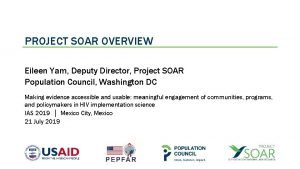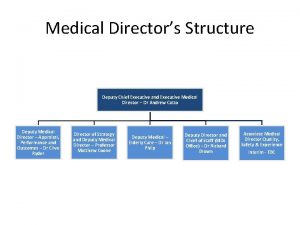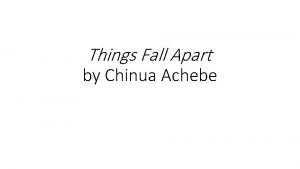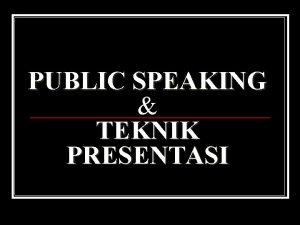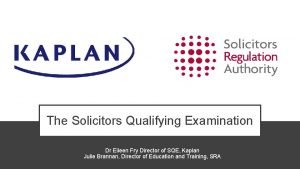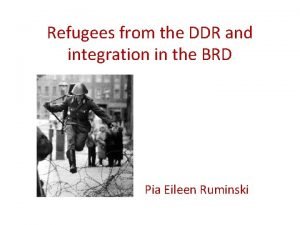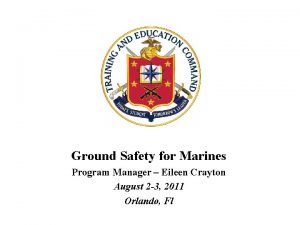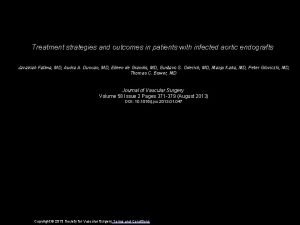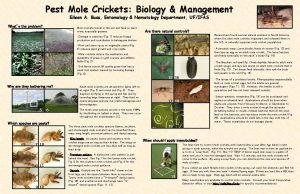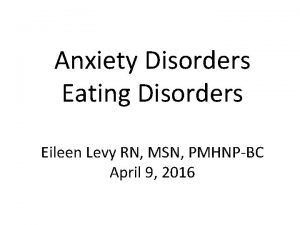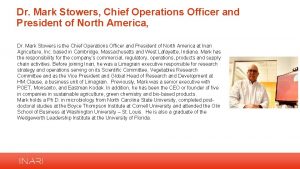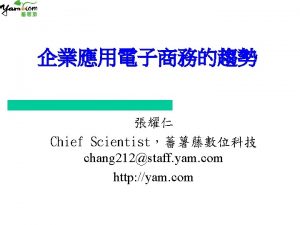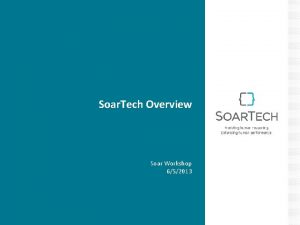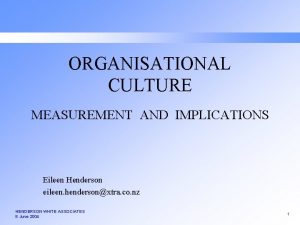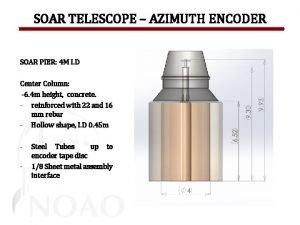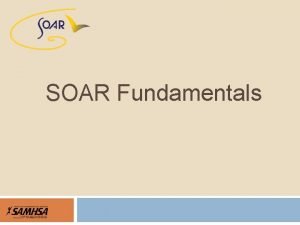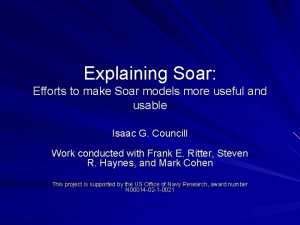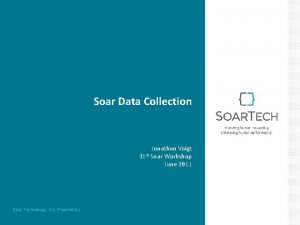PROJECT SOAR OVERVIEW Eileen Yam Deputy Director Project



















- Slides: 19

PROJECT SOAR OVERVIEW Eileen Yam, Deputy Director, Project SOAR Population Council, Washington DC Making evidence accessible and usable: meaningful engagement of communities, programs, and policymakers in HIV implementation science IAS 2019 │ Mexico City, Mexico 21 July 2019

Project SOAR (Supporting Operational AIDS Research) • Global HIV and AIDS operations research to inform programs and policy • PEPFAR-funded 6 -year cooperative agreement (2014 – 20) • Led by Population Council with global consortium partners: § § § Avenir Health Elizabeth Glaser Pediatric AIDS Foundation Johns Hopkins University Palladium The University of North Carolina

SOAR research portfolio 72 activities in 21 countries

SOAR thematic areas • Test and start • Community-based treatment and support • Key populations • Pediatric/child/adolescent treatment and PMTCT • Gender and stigma • Voluntary male medical circumcision (VMMC) (costing, modeling)

Project SOAR: three key results Improve HIV and AIDS program outcomes through operational research R 1: Conduct high-quality OR studies R 2: Strengthen capacity to conduct (and consume) operational research R 3: Promote use of study results to guide planning, funding, and implementation

SOAR’S Research Utilization Process Samuel Kalibala, Senior Research Utilization Advisor Palladium/Project SOAR Making evidence accessible and usable: meaningful engagement of communities, programs, and policymakers in HIV implementation science IAS 2019 │ Mexico City, Mexico 21 July 2019

Result 3—Research utilization (RU) R 1: Conduct high-quality OR studies Effective dissemination of OR findings through multiple channels Improve HIV and AIDS program outcomes through operational research R 2: Strengthen capacity to conduct (and consume) operational research Changes to practice and policy due to SOAR activities R 3: Promote use of study results to guide planning, funding, and implementation Improved tracking of how SOAR research has been utilized for program and policy changes

RU builds bridges between researchers and program managers and policy makers RU RESEARCH Controlled Empirical Objective Highlights context PROGRAM Practical Urgent Action. Oriented Engages stakeholders Supports use of findings Builds ownership POLICY Bargaining Lobbying Compromising

Key RU practices • Identify and engage key stakeholders during the research process • Hold data interpretation meeting(s) • Disseminate findings • Develop RU plan to use findings and recommendations • Implement RU plan and document utilization

IDENTIFY AND ENGAGE KEY STAKEHOLDERS DURING THE RESEARCH PROCESS

Whom does SOAR engage? • Stakeholders at multiple levels: § § § § beneficiaries service providers national and sub-national government civil society donors academia UN agencies

How does SOAR engage them? • Co-investigators: § Involvement in all aspects of the research process • Discussants of preliminary and final results: § Research advisory committees (RACs) § Existing technical working groups (TWGs) § Targeted meetings • Capacity-strengthening § Design, conduct, and utilize research

Lesotho: IMPROVE • What did we learn? § Insufficient number of qualified team members to track LTFU mothers • How were stakeholders engaged? § Study design and updates presented to Ped TWG § Presentation of baseline findings to District Health Management Team (DHMT) • What happened? § Recruited and trained 46 new village health workers

Uganda: Stigma Index • What did we learn? § High levels of stigma • How were stakeholders engaged? § Data collected by community members § Findings presented to DHMT • What happened? § DHMT included stigma reduction interventions in annual work plan

Zambia: Evaluation of ZAMFAM • What did we learn? § Less than 10% of OVC had a birth certificate § HIV status of only 53% of OVC was known to the caregiver • How were stakeholders engaged? § Ministry of Community Development chaired the RAC § Presentation of baseline findings at RAC meeting attended by IPs • What happened? § IPs modified work plans to assist OVC in getting birth certificates and encourage access to HTS

Strengthening capacity to use data to inform HIV responses for key populations • What did we learn? § HIV prevalence, incidence, population size estimation, etc. across countries. Data synthesized and deposited in central repository • How were stakeholders engaged? § Policymakers (UNAIDS, Global Fund, USAID missions, MOH) through meetings/conference calls • What happened? § Requests for data pulls from repository for decision-making (e. g. , COP process)

Conclusions and recommendations • Decision-makers exist at all levels and can be involved through various mechanisms. • Decision-makers can make immediate use of research results. • Research projects should build in mechanisms to engage decision-makers with preliminary and final study results.

There’s hope for Cecilia

Thank You RESEARC H RESOURC ES EVENTS NEWS Visit projsoar. org! Project SOAR (Cooperative Agreement AID-OAA-A-14 -00060) is made possible by the generous support of the American people through the President’s Emergency Plan for AIDS Relief (PEFPAR) and United States Agency for International Development (USAID). The contents of this presentation are the sole responsibility of Project SOAR and Population Council and do not necessarily reflect the views of USAID or the United States Government. Through operations research, Project SOAR will determine how best to address challenges and gaps that remain in the delivery of HIV and AIDS care and support, treatment, and prevention services. Project SOAR is producing a large, multifaceted body of high-quality evidence to guide the planning and implementation of HIV and AIDS programs and policies. Led by the Population Council, Project SOAR is implemented in collaboration with Avenir Health, Elizabeth Glaser Pediatric AIDS Foundation, Johns Hopkins University, Palladium, and The University of North Carolina.
 Eileen yam
Eileen yam Deputy medical director
Deputy medical director Movin on up minute to win it game
Movin on up minute to win it game Yam tw
Yam tw Locust symbolism in things fall apart
Locust symbolism in things fall apart Teknik yam dalam presentasi
Teknik yam dalam presentasi Eileen rakowski
Eileen rakowski Eileen fry
Eileen fry Eileen o'shaughnessy
Eileen o'shaughnessy Dr eileen dahl
Dr eileen dahl 1939
1939 Pia eileen ruminski
Pia eileen ruminski Ground safety for marines
Ground safety for marines Eileen degrandis md
Eileen degrandis md Puppy linux 2017
Puppy linux 2017 Eileen mole
Eileen mole Chinese companies in ireland
Chinese companies in ireland Eileen levy
Eileen levy Deputy stowers
Deputy stowers Poe balance manifesto
Poe balance manifesto
